Bio Plasticizers Market Size
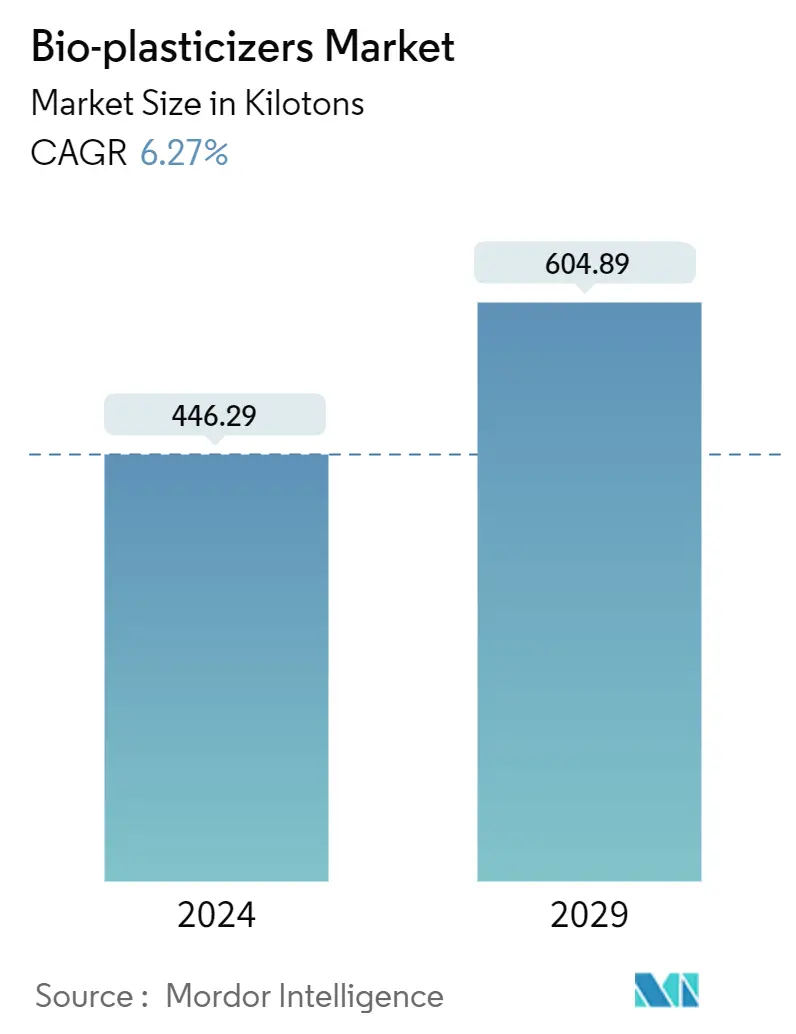
| Study Period | 2019 - 2029 |
| Base Year For Estimation | 2023 |
| CAGR (2024 - 2029) | 6.27 % |
| Fastest Growing Market | Europe |
| Largest Market | Asia-Pacific |
| Market Concentration | High |
Major Players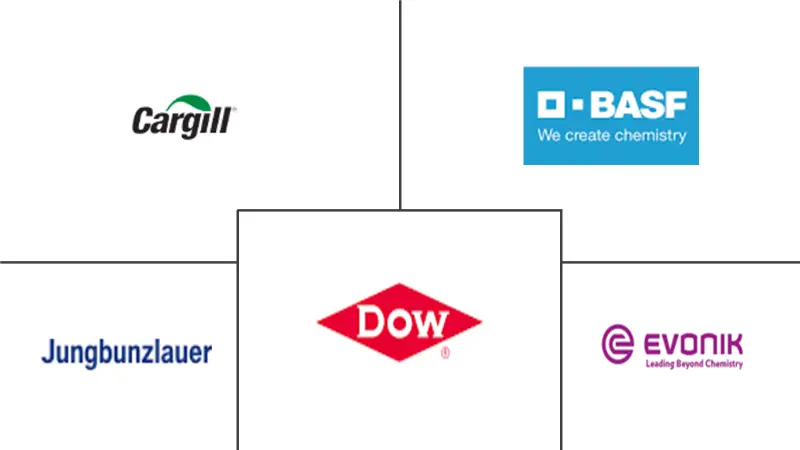
*Disclaimer: Major Players sorted in no particular order |
Bio Plasticizers Market Analysis
The Bio-plasticizers Market size is estimated at 446.29 kilotons in 2024, and is expected to reach 604.89 kilotons by 2029, growing at a CAGR of 6.27% during the forecast period (2024-2029).
COVID-19 negatively impacted the market in 2020. During the pandemic, construction activities were temporarily halted due to the government-imposed lockdown. This led to a decrease in the consumption of bio-plasticizers based on flooring and wall coverings, wires, and cables, which, in turn, negatively impacted the demand for bio-plasticizers. However, the demand for packaging from the food and e-commerce segment significantly increased during this situation, which, in turn, stimulated the demand for packaging materials made up of bio-plasticizers, thus enhancing the market growth.
- Over the short term, the augmenting demand for bio-plasticizers for flexible PVC and the prohibition on phthalate-based plasticizers are expected to drive the growth of the market.
- The high cost of bio-plasticizers, when compared with conventional plasticizers, is likely to hinder the growth of the market.
- Ongoing research on bio-based plasticizers is likely to create opportunities for the market during the forecast period.
- The Asia-Pacific region is expected to dominate the market. It is also likely to witness the highest CAGR during the forecast period.
Bio Plasticizers Market Trends
Increasing Demand from Flooring, Roofing and Wall Covering
- Bio-plasticizers help reduce water requirements and make concrete strong and workable. These are generally organic substances or a combination of organic and inorganic substances that help reduce water content for workability.
- The quantity of plasticizers added is about 0.1%-0.4% by weight of cement. This amount reduces 5%-15% of the water requirement and also leads to an increase in workability from about a 3-8 cm slump. A plasticizer, in general, entrains less than 2% air.
- According to the National Bureau of Statistics of China, the output value of the construction works in the country accounted for CNY 25.92 trillion (USD 4.02 trillion) in 2021, compared to CNY 23.27 trillion (USD 3.37 trillion) in 2020. This led to an increase in the demand for flooring and wall covering, which, in turn, increased the demand for the bioplasticizers market.
- In India, the construction sector is an important pillar for the growth of the economy. The government is taking a number of steps to make sure that the country has good infrastructure by a certain date.The Indian government has been actively boosting housing construction as it aims to provide houses to about 1.3 billion people.
- Furthermore, according to the US Census Bureau, the annual value of new construction put in place in the United States accounted for USD 1,792 billion in 2022, compared to USD 1,626 billion in 2021. Moreover, the annual value of residential construction put in place in the United States was valued at USD 908 billion in 2022, an increase of 13% compared to USD 803 billion in 2021.
- Thus, with the growing demand for the conservation of water resources, the use of plasticizers is rapidly increasing in flooring and wall coverings.
- Owing to all these factors, the demand for bio-plasticizers is likely to grow across the world during the forecast period.
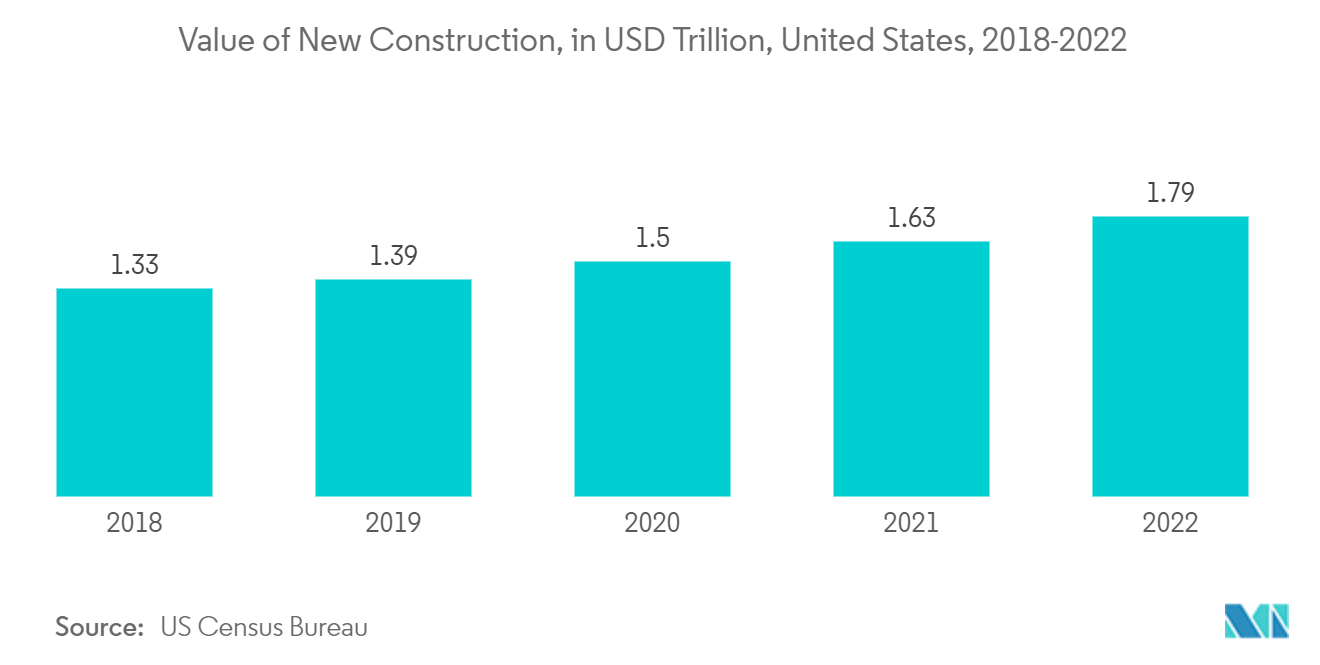
The Asia-Pacific Region to Dominate the Market Growth
- The Asia-Pacific construction industry is the largest in the world. It is growing at a healthy rate because the middle class is getting richer and more people are moving to cities.
- The expansion of the industry has also benefited from the addition of infrastructure and the entry of significant players from the European Union into China's lucrative market.
- China's construction industry has developed rapidly in the past few years, due to the central government's push for infrastructure investment as a means to sustain economic growth. China was leading in the construction industry, with an added value of USD 1.29 trillion in 2022.
- Also, the total floor space of new homes built in Japan in 2022 was about 69 million square meters, which was less than the 70 million square meters built in 2021. Additionally, in 2022, approximately 859,500 housing starts were initiated in Japan. This led to an increase in the consumption of bio-plasticizers for applications like wire, cables, flooring, and wall coverings.
- Foreign investment restrictions have also been lifted for land development, high-end hotels, office buildings, international exhibition centers, and building and running big theme parks. Over the next few years, the bioplasticizers market in the region is likely to grow due to growth in the infrastructure and transportation sectors.
- The Packaging Industry Association of India (PIAI) also says that India is becoming a place where the plastic packaging industry likes to be. The packaging industry is the fifth-largest sector in the Indian economy.
- The healthcare industry is growing steadily, with spending on healthcare and the number of medical facilities in the country going up every year. Indian government policies that have been made more open have also made it possible for 100% foreign direct investment in the medical devices market.
- In India, the government introduced the world's largest government-funded healthcare program, the NHP Scheme. In the Economic Survey of 2022, India's public expenditure on healthcare stood at 2.1% of GDP in 2021-22, compared with 1.8% in 2020-21. Additionally, the Indian government is planning to introduce a credit incentive program worth INR 500 billion (USD 6.8 billion) to boost the country's healthcare infrastructure.
- Therefore, the abovementioned factors are expected to have a significant impact on the market during the forecast period.
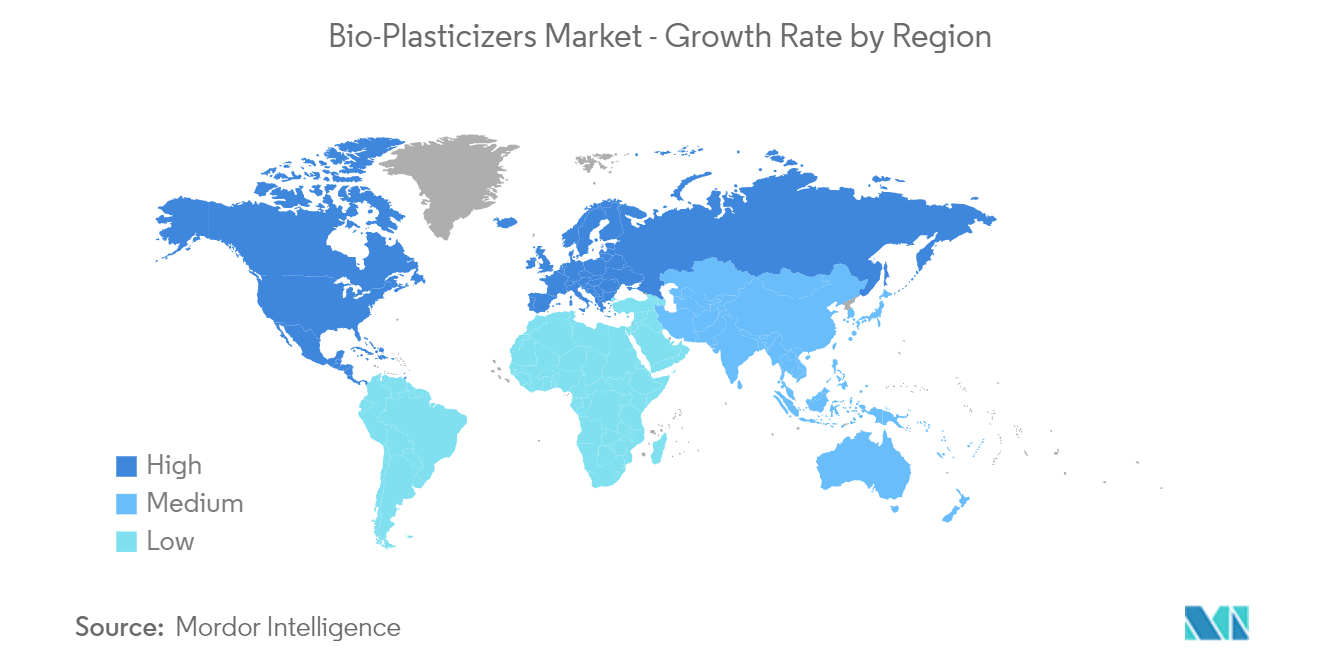
Bio Plasticizers Industry Overview
The bio-plasticizers market is partially consolidated in nature. Some major players in the market (not in any particular order) include Dow, Evonik Industries AG, Cargill, Inc., BASF SE, and Jungbunzlauer Suisse AG, among others.
Bio Plasticizers Market Leaders
-
Dow
-
Cargill, Inc.
-
BASF SE
-
Jungbunzlauer Suisse AG
-
Evonik Industries AG
*Disclaimer: Major Players sorted in no particular order
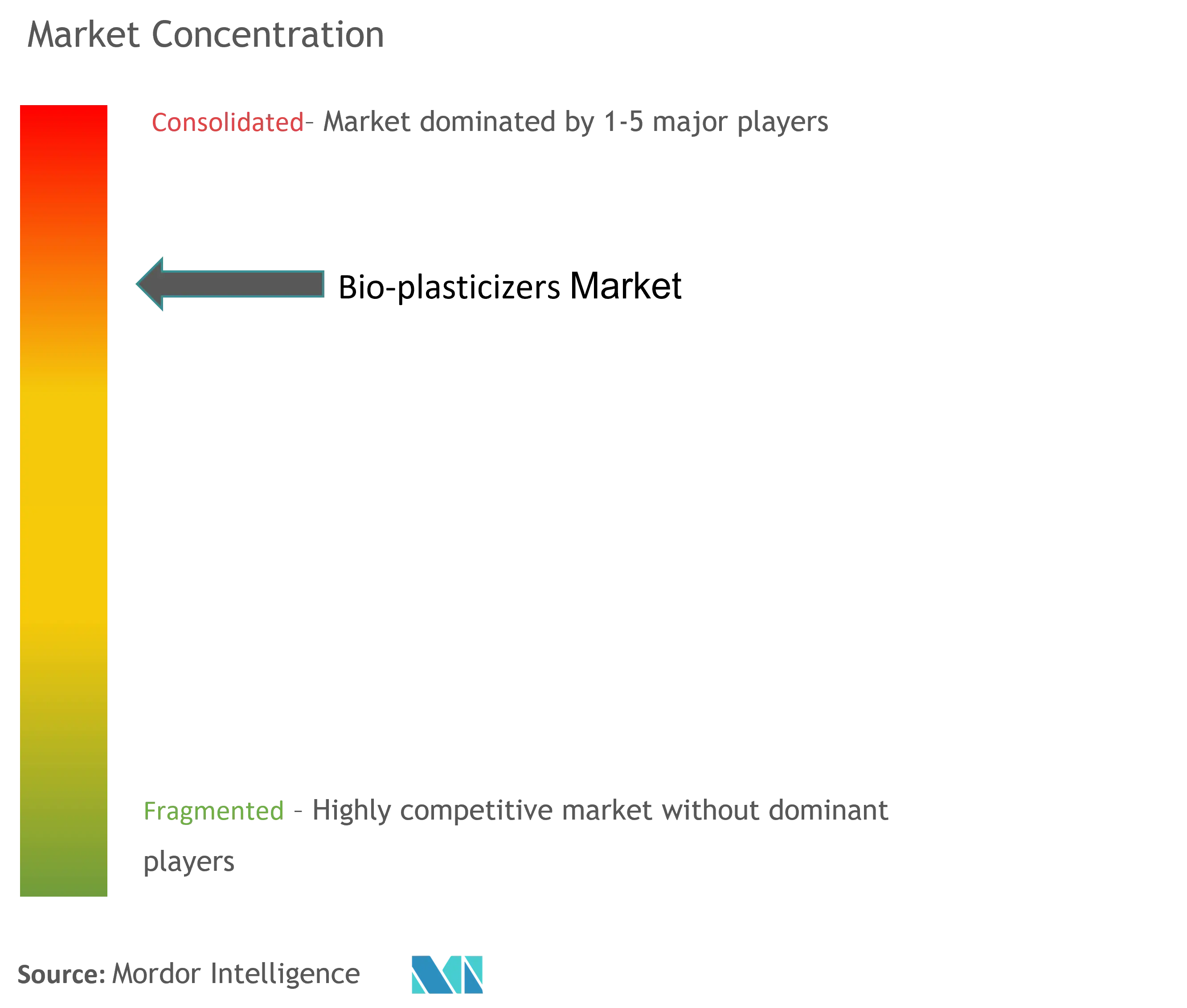
Bio Plasticizers Market News
- November 2022: Evonik Industries is centralizing and expanding its reach. It launched its first digital platform, 'myFLEXINO,' for plasticizers to effectively and efficiently extend its products and services to consumers.
- August 2022: The Hallstar Company, a specialty chemicals company acquired an ester manufacturing facility in Greensboro, North Carolina, from German specialty chemicals maker Lanxess. This site has significant assets that produce environmentally friendly phthalate-free plasticizers which will help to expand the product portfolio of Hallstar Company.
Bio Plasticizers Market Report - Table of Contents
1. INTRODUCTION
- 1.1 Study Assumptions
- 1.2 Scope of the Study
2. RESEARCH METHODOLOGY
3. EXECUTIVE SUMMARY
4. MARKET DYNAMICS
-
4.1 Drivers
- 4.1.1 Increasing Demand for Flexible PVC
- 4.1.2 Stringent Phthalate Regulations to Boost the Use of Bio-Plasticizers
-
4.2 Restraints
- 4.2.1 Availability of Alternatives to bio-plasticizers
- 4.2.2 Other Restraints
- 4.3 Industry Value Chain Analysis
-
4.4 Porter's Five Forces Analysis
- 4.4.1 Bargaining Power of Suppliers
- 4.4.2 Bargaining Power of Consumers
- 4.4.3 Threat of New Entrants
- 4.4.4 Threat of Substitute Products and Services
- 4.4.5 Degree of Competition
5. MARKET SEGMENTATION (Market Size in Volume)
-
5.1 By Type
- 5.1.1 Epoxidized Soybean Oil (ESBO)
- 5.1.2 Castor Oil
- 5.1.3 Citrates
- 5.1.4 Succinic Acid
- 5.1.5 Other Types
-
5.2 By Application
- 5.2.1 Wire and Cables
- 5.2.2 Film and Sheet
- 5.2.3 Flooring, Roofing and Wall Covering
- 5.2.4 Medical Devices
- 5.2.5 Consumer Goods
- 5.2.6 Other Applications
-
5.3 By Geography
- 5.3.1 Asia-Pacific
- 5.3.1.1 China
- 5.3.1.2 India
- 5.3.1.3 Japan
- 5.3.1.4 South Korea
- 5.3.1.5 Rest of Asia-Pacific
- 5.3.2 North America
- 5.3.2.1 United States
- 5.3.2.2 Canada
- 5.3.2.3 Mexico
- 5.3.3 Europe
- 5.3.3.1 Germany
- 5.3.3.2 United Kingdom
- 5.3.3.3 Italy
- 5.3.3.4 France
- 5.3.3.5 Rest of Europe
- 5.3.4 South America
- 5.3.4.1 Brazil
- 5.3.4.2 Argentina
- 5.3.4.3 Rest of South America
- 5.3.5 Middle East and Africa
- 5.3.5.1 Saudi Arabia
- 5.3.5.2 South Africa
- 5.3.5.3 Rest of Middle East and Africa
6. COMPETITIVE LANDSCAPE
- 6.1 Mergers and Acquisitions, Joint Ventures, Collaborations, and Agreements
- 6.2 Market Ranking Analysis
- 6.3 Strategies Adopted by Leading Players
-
6.4 Company Profiles
- 6.4.1 Avient Corporation
- 6.4.2 BASF SE
- 6.4.3 Cargill, Inc.
- 6.4.4 DIC CORPORATION
- 6.4.5 Dow
- 6.4.6 Emery Oleochemicals
- 6.4.7 Evonik Industries AG
- 6.4.8 Hebei Jingu Plasticizer Co. Ltd.
- 6.4.9 Jiangxi East Huge Dragon Chemical Co. Ltd.
- 6.4.10 Jungbunzlauer Suisse AG
- 6.4.11 LANXESS
- 6.4.12 Matrica SpA
- 6.4.13 OQ Chemicals gmbH
- 6.4.14 Roquette Freres
- *List Not Exhaustive
7. MARKET OPPORTUNITIES AND FUTURE TRENDS
- 7.1 Growing Research In Bio-Based Plasticizers
Bio Plasticizers Industry Segmentation
Bio-plasticizers are polymer materials derived from renewable sources, including vegetable oil and biomass. It can be considered a substitute for polyvinyl chloride (PVC). It finds its major application in end-user industries, including building and construction, electronics, and automotive.
The market is segmented by type, application, and geography. By type, the market is segmented into epoxidized soybean oil, castor oil, citrates, succinic acid, and other types. By application, the market is segmented into wire and cables, film and sheet, flooring, roofing, wall coverings, medical devices, consumer goods, and other applications. The report also covers the market sizes and forecasts for bio-plasticizers in 15 countries across major regions. For each segment, the market sizes and forecasts have been done in terms of volume (tons).
| By Type | Epoxidized Soybean Oil (ESBO) | |
| Castor Oil | ||
| Citrates | ||
| Succinic Acid | ||
| Other Types | ||
| By Application | Wire and Cables | |
| Film and Sheet | ||
| Flooring, Roofing and Wall Covering | ||
| Medical Devices | ||
| Consumer Goods | ||
| Other Applications | ||
| By Geography | Asia-Pacific | China |
| India | ||
| Japan | ||
| South Korea | ||
| Rest of Asia-Pacific | ||
| By Geography | North America | United States |
| Canada | ||
| Mexico | ||
| By Geography | Europe | Germany |
| United Kingdom | ||
| Italy | ||
| France | ||
| Rest of Europe | ||
| By Geography | South America | Brazil |
| Argentina | ||
| Rest of South America | ||
| By Geography | Middle East and Africa | Saudi Arabia |
| South Africa | ||
| Rest of Middle East and Africa |
Bio Plasticizers Market Research FAQs
How big is the Bio-plasticizers Market?
The Bio-plasticizers Market size is expected to reach 446.29 kilotons in 2024 and grow at a CAGR of 6.27% to reach 604.89 kilotons by 2029.
What is the current Bio-plasticizers Market size?
In 2024, the Bio-plasticizers Market size is expected to reach 446.29 kilotons.
Who are the key players in Bio-plasticizers Market?
Dow, Cargill, Inc., BASF SE, Jungbunzlauer Suisse AG and Evonik Industries AG are the major companies operating in the Bio-plasticizers Market.
Which is the fastest growing region in Bio-plasticizers Market?
Europe is estimated to grow at the highest CAGR over the forecast period (2024-2029).
Which region has the biggest share in Bio-plasticizers Market?
In 2024, the Asia-Pacific accounts for the largest market share in Bio-plasticizers Market.
What years does this Bio-plasticizers Market cover, and what was the market size in 2023?
In 2023, the Bio-plasticizers Market size was estimated at 418.31 kilotons. The report covers the Bio-plasticizers Market historical market size for years: 2019, 2020, 2021, 2022 and 2023. The report also forecasts the Bio-plasticizers Market size for years: 2024, 2025, 2026, 2027, 2028 and 2029.
Bio Plasticizers Industry Report
The Bio Plasticizer Market is segmented by type, application, and geography, providing a comprehensive market analysis. The market growth is driven by the increasing demand for sustainable and eco-friendly plasticizers. The market value is anticipated to rise as industries shift towards bio-based alternatives. According to industry reports, the market share of bio plasticizers is expanding across various applications such as wire and cables, films and sheets, and medical devices.
Industry analysis indicates that the Asia-Pacific region is leading the market, followed by North America and Europe. The market forecast suggests a positive outlook for the coming years, with significant contributions from market leaders in the sector. The market size is expected to grow, supported by advancements in technology and increased consumer awareness.
The industry overview highlights the key drivers, challenges, and opportunities within the market. Market trends show a shift towards non-phthalate plasticizers, which are gaining popularity due to their lower environmental impact. The industry outlook remains optimistic, with continued investments in research and development.
Market data reveals that the demand for bio plasticizers is increasing in consumer goods and medical devices. The market predictions indicate sustained growth, supported by favorable government regulations and initiatives promoting the use of bio-based products. The market review underscores the importance of innovation and strategic partnerships in maintaining a competitive edge.
In conclusion, the bio plasticizer market is poised for significant expansion, driven by market segmentation and a robust market forecast. The industry research highlights the potential for growth and the importance of adapting to market trends. The report example provided offers valuable insights into the market dynamics, making it a useful resource for stakeholders. The report pdf is available for further details, providing a comprehensive overview of the market landscape.



